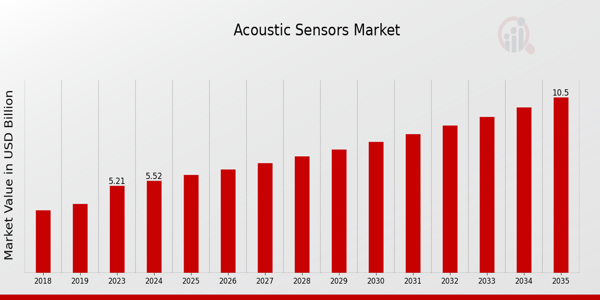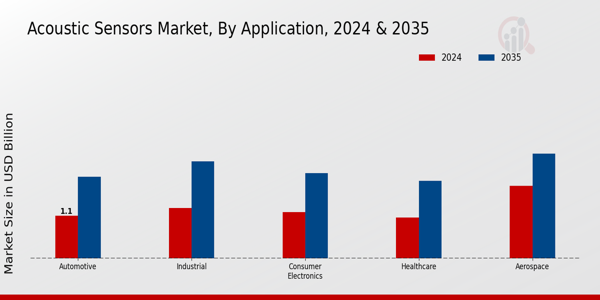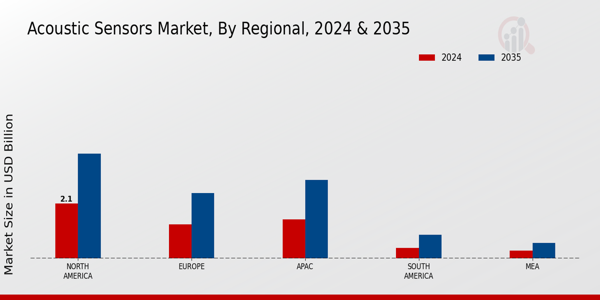Acoustic Sensors Market Overview
Acoustic Sensors Market Size was estimated at 5.21 (USD Billion) in 2023. The Acoustic Sensors Industry is expected to grow from 5.52 (USD Billion) in 2024 to 10.5 (USD Billion) by 2035.
The Acoustic Sensors Market CAGR (growth rate) is expected to be around 6.02% during the forecast period (2025 - 2035).
Key Acoustic Sensors Market Trends Highlighted
The Acoustic Sensors Market is witnessing significant growth driven by increasing demand for advanced sensing solutions across various sectors. Key market drivers include the rising adoption of smart technologies in industrial settings and an increased focus on safety in transportation. The growing need for real-time monitoring systems in industries such as oil and gas, manufacturing, and environmental monitoring further propels the market. These sensors enhance the accuracy of data collection and analysis, providing better operational insights, which is essential for decision-making processes. Furthermore, there are substantial opportunities in smart city initiatives, where acoustic sensors play a crucial role in traffic management and urban planning. The integration of Internet of Things (IoT) technology with acoustic sensors opens avenues for innovative applications, enhancing their utility in surveillance, building automation, and public safety systems. As cities look to optimize resources and improve quality of life, the potential for acoustic sensors in urban areas is immense. Recent trends indicate a shift towards miniaturization and greater sensitivity in acoustic sensor designs. This evolution allows for more compact solutions that can be easily integrated into various devices, contributing to the development of wearables and portable monitoring systems. Additionally, the combination of artificial intelligence with acoustic sensing technology creates sophisticated analytical tools that can predict system failures and enhance efficiency. As industries and governments increasingly recognize the value of acoustic sensors in operations, the momentum for research and development in this field is expected to continue, fostering innovation and driving the market forward.

Source: Primary Research, Secondary Research, MRFR Database and Analyst Review
Acoustic Sensors Market Drivers
Growing Demand for Smart Technologies
The increasing integration of smart technologies across various industries significantly drives the Acoustic Sensors Market Industry. As urbanization accelerates, there is a burgeoning need for smart city solutions that enhance the quality of life for residents. Acoustic sensors play a vital role in smart city initiatives by contributing to noise pollution monitoring, traffic management and infrastructure health monitoring. The rising trend of connectivity in many sectors, such as healthcare, manufacturing, and automotive, has led to a heightened demand for advanced sensing technologies. Acoustic sensors have emerged as essential components in areas like healthcare monitoring where they facilitate non-invasive patient monitoring, enabling early detection of medical conditions. In manufacturing processes, the need for operational efficiency spurs the demand for acoustic sensors, which can detect machinery sounds and vibrations indicative of operational issues. Thus, the market for acoustic sensors is positively impacted by the growing emphasis on integrating smart technologies into everyday life as cities and industries aim to create more efficient, responsive environments.
Advancements in Sensor Technologies
Rapid advancements in sensor technologies are a significant driver for the Acoustic Sensors Market Industry. With continuous research and development, the capabilities of acoustic sensors have been enhanced, enabling them to deliver improved accuracy, sensitivity and reliability. These advancements have paved the way for their application in various fields, including healthcare, security, and environmental monitoring. The deployment of cutting-edge material science in sensor design has led to the development of compact and lightweight sensors that can be easily integrated into existing systems. Moreover, innovations in signal processing algorithms have made it possible to filter out background noise, thereby allowing for more precise acoustic measurements. Enhanced performance not only increases the efficiency of existing applications but also opens doors to new uses of acoustic sensors that were previously impractical or unattainable.
Increased Awareness of Environmental Issues
The growing awareness of environmental issues and the need for sustainable practices significantly boost the Acoustic Sensors Market Industry. As communities strive to manage noise pollution and its impact on public health, acoustic sensors are increasingly utilized to monitor sound levels and promote compliance with regulatory standards. This heightened focus on the environment encourages the adoption of acoustic sensors in various sectors, including construction, transportation and urban planning.
Acoustic Sensors Market Segment Insights:
Acoustic Sensors Market Application Insights
The Acoustic Sensors Market is poised for significant expansion, particularly within the Application segment, which encompasses various industries including Automotive, Industrial, Consumer Electronics, Healthcare and Aerospace. In 2024, the market is valued at 5.52 USD Billion, signaling robust growth opportunities across the applications. The Automotive segment, valued at 1.1 USD Billion in 2024 and projected to grow to 2.1 USD Billion by 2035, holds a significant share, driven by the increasing demand for advanced driver-assistance systems (ADAS) and enhanced safety features in vehicles. This demand illustrates the critical role of acoustic sensors in providing real-time feedback on vehicle environments. The Industrial sector is also noteworthy, valued at 1.3 USD Billion in 2024 and expected to rise to 2.5 USD Billion by 2035, reflecting a growing trend towards automation and monitoring systems. Acoustic sensors play an essential role in predictive maintenance and operational efficiency, aiding industries in reducing downtime. The Consumer Electronics market, valued at 1.2 USD Billion in 2024 and anticipated to reach 2.2 USD Billion by 2035, showcases the importance of sound recognition technologies in smart devices and home automation systems.
The Healthcare segment, while slightly lower at 1.05 USD Billion in 2024 and moving to 2.0 USD Billion by 2035, highlights how acoustic sensors facilitate innovations in patient monitoring and diagnostics, becoming increasingly vital in medical technology. Lastly, the Aerospace sector is projected to grow from 1.87 USD Billion in 2024 to 2.7 USD Billion by 2035, underscoring the importance of acoustic sensors in navigation and communication systems, which are critical for safety and operational integrity in aviation. Together, these segments illustrate the diverse applications and growing significance of the Acoustic Sensors Market, supported by various growth drivers and trends that enhance market growth and opportunities across all these sectors. The increasing adoption of smart technology and automation in different fields provides further impetus to the Acoustic Sensors Market, influencing the market segmentation and presenting compelling statistics to underscore its expansion.

Source: Primary Research, Secondary Research, MRFR Database and Analyst Review
Acoustic Sensors Market Technology Insights
The Acoustic Sensors Market revenue is expected to reach. The market is characterized by its diverse segmentation, including key technologies such as Microphone Sensors, Ultrasonic Sensors, Vibration Sensors and Accelerometer Sensors. Microphone Sensors are critical for capturing audio signals across various applications, from consumer electronics to automotive systems. Ultrasonic Sensors have gained traction in industrial automation and healthcare, proving essential for non-invasive monitoring and measurement solutions. Vibration Sensors play a crucial role in structural monitoring and predictive maintenance, enabling timely interventions that enhance operational efficiency. Accelerometer Sensors dominate in applications involving motion detection and orientation sensing across multiple industries, from gaming to aerospace. Market growth is further fueled by advancements in sensor technology and the expanding scope of applications across various industries, shaping the overall Acoustic Sensors Market statistics.
Acoustic Sensors Market End Use Insights
The Acoustic Sensors Market revenue has been on an upward trajectory. As the market continues to expand, it has become evident that end-use applications play a critical role. The market segmentation encompasses various sectors, notably Residential, Commercial, and Industrial. The Residential sector is significant as it addresses the growing demand for smart home technologies, allowing for enhanced security and automation. The Commercial segment captures a considerable share, driven by the increasing need for acoustic monitoring in various business environments, ensuring operational efficiency and safety. The Industrial sector predominates due to its robust applications in manufacturing processes, equipment diagnostics, and environmental monitoring, proving essential for maintaining productivity and compliance. Trends such as the integration of Internet of Things (IoT) solutions and advancements in sensor technology are contributing to the market growth. Additionally, challenges such as sensor compatibility and high initial costs may hinder adoption, yet they offer opportunities for innovation and improved functionality in the acoustic sensors landscape. The Acoustic Sensors Market data reflects a promising future with the industrial segment holding a majority share, vital for technological advancements and competitive strategies.
Acoustic Sensors Market Product Type Insights
The Acoustic Sensors Market is categorized by Product Type into Contact Sensors, Non-contact Sensors, and Array Sensors, each playing a crucial role in diverse applications. Contact Sensors are often favored in manufacturing and industrial settings due to their accuracy in detecting sound variations when in physical touch with surfaces. Non-contact Sensors, on the other hand, are essential for applications requiring distance measurement without interference, such as in environmental monitoring and smart city initiatives, making them increasingly popular. Array Sensors are recognized for their capability to provide high-resolution data and spatial awareness, which is significant in areas like robotics and automation. The growth drivers for these product types include advancements in sensor technology and the rising need for efficient monitoring systems. However, challenges such as high initial costs and competition from alternative technologies may impact market dynamics. Overall, the segmentation of the Acoustic Sensors Market underscores a range of application potentials and evolving opportunities for innovation in the industry.
Acoustic Sensors Market Regional Insights
The Acoustic Sensors Market showcases a diverse regional segmentation with distinct valuations across various areas. In 2024, North America leads with a valuation of 2.1 USD Billion, reflecting its significant demand for advanced sensor technologies crucial in automotive and industrial applications. Europe follows with a valuation of 1.3 USD Billion, driven by stringent regulations promoting environmental safety and innovations in sound measurement. The APAC region holds a valuation of 1.5 USD Billion in 2024, fueled by rapid industrialization and a growing focus on smart technologies. South America and MEA, while smaller, also contribute with valuations of 0.4 USD Billion and 0.3 USD Billion respectively, benefiting from evolving infrastructure and rising awareness of environmental monitoring. The regional distribution underlines a substantial growth potential driven by technological advancements and an increasing emphasis on efficient sound management systems across various industries, creating opportunities for market expansion and broader applications in the future.

Source: Primary Research, Secondary Research, MRFR Database and Analyst Review
Acoustic Sensors Market Key Players and Competitive Insights:
The Acoustic Sensors Market is characterized by its dynamic and rapidly evolving nature, driven by advancements in technology and an increasing demand for innovative sensing solutions. As various industries recognize the importance of acoustic sensors in applications ranging from environmental monitoring to healthcare and industrial automation, competition among key players is intensifying. Companies are focusing on enhancing their product offerings, investing in research and development, and forming strategic partnerships to expand their market share. Furthermore, factors such as the growth of the Internet of Things and smart technologies are pushing the boundaries of what acoustic sensors can achieve, enabling more sophisticated and accurate data collection and analysis. This competitive landscape is shaped not only by market leaders but also by emerging startups that are bringing novel ideas and solutions to the forefront. Sennheiser Electronic has established a notable presence in the Acoustic Sensors Market through its commitment to quality and innovation in audio technology. The company is widely recognized for its expertise in developing advanced acoustic sensing devices that cater to a wide range of applications, including professional audio, broadcasting and personal communication.
Sennheiser’s strengths lie in its robust research and development capabilities, which allow it to stay ahead of market trends and continuously improve its product portfolio. By leveraging its deep understanding of sound capture and transmission technologies, the company successfully delivers high-performance acoustic sensors that meet the demands of diverse industries. Additionally, Sennheiser's emphasis on customer satisfaction and its reputation for durability and reliability further bolster its competitive stance in the market. Acoem Group has carved a niche for itself within the Acoustic Sensors Market, focusing on developing innovative solutions for monitoring and analyzing sound and vibration levels. With a strong emphasis on precision and accuracy, Acoem Group's products are designed to address the particular needs of various sectors, including environmental monitoring, industrial operations, and transportation. The company harnesses its extensive experience and expertise to provide reliable acoustic sensing technologies that aid in maintaining regulatory compliance and enhancing overall operational efficiency for its clients. Acoem Group's portfolio features advanced sensing solutions that incorporate cutting-edge technology, ensuring that its offerings are not only innovative but also user-friendly. This strong market presence bolstered by a commitment to quality and effective customer support helps Acoem Group maintain a competitive edge within the acoustic sensors landscape.
Key Companies in the Acoustic Sensors Market Include:
- Sennheiser Electronic
- Acoem Group
- Murata Manufacturing
- Siemens
- Emerson Electric
- 3M
- NXP Semiconductors
- Ocean Infinity
- Analog Devices
- Microchip Technology
- Bose Corporation
- Akustica
- Honeywell
- Texas Instruments
- TE Connectivity
Acoustic Sensors Industry Developments
Recent developments in the Acoustic Sensors Market have been marked by advancements in technology and significant mergers between key players. Companies like Sennheiser Electronic and Micron Technology are focusing on enhancing sound quality and noise-canceling features, a trend gaining traction across industries. Meanwhile, Murata Manufacturing and Siemens have been investing in acoustic sensor research to incorporate smart technology into their products. Emerson Electric’s collaboration with firms specializing in IoT is further driving innovations.
Notably, there has been a merger between 3M and a smaller tech firm, allowing 3M to expand its portfolio in acoustic sensing solutions. Honeywell's acquisition of a start-up focused on advanced acoustic sensor technology is also indicative of the market's growth trajectory. Additionally, Analog Devices and Texas Instruments have seen an increase in market valuation, bolstering investor confidence and enhancing their competitive positions. As demand for smarter and more integrated acoustic functionalities grows, companies are strategically enhancing their offerings, contributing to the expanding Acoustic Sensors Market.
Acoustic Sensors Market Segmentation Insights
Acoustic Sensors Market Application Outlook
- Automotive
- Industrial
- Consumer Electronics
- Healthcare
- Aerospace
Acoustic Sensors Market Technology Outlook
- Microphone Sensors
- Ultrasonic Sensors
- Vibration Sensors
- Accelerometer Sensors
Acoustic Sensors Market End Use Outlook
- Residential
- Commercial
- Industrial
Acoustic Sensors Market Product Type Outlook
- Contact Sensors
- Non-contact Sensors
- Array Sensors
Acoustic Sensors Market Regional Outlook
- North America
- Europe
- South America
- Asia Pacific
- Middle East and Africa
| Attribute/Metric Source: |
Details |
| MARKET SIZE 2023 |
5.21 (USD Billion) |
| MARKET SIZE 2024 |
5.52 (USD Billion) |
| MARKET SIZE 2035 |
10.5 (USD Billion) |
| COMPOUND ANNUAL GROWTH RATE (CAGR) |
6.02% (2025 - 2035) |
| REPORT COVERAGE |
Revenue Forecast, Competitive Landscape, Growth Factors, and Trends |
| BASE YEAR |
2024 |
| MARKET FORECAST PERIOD |
2025 - 2035 |
| HISTORICAL DATA |
2019 - 2024 |
| MARKET FORECAST UNITS |
USD Billion |
| KEY COMPANIES PROFILED |
Sennheiser Electronic, Acoem Group, Murata Manufacturing, Siemens, Emerson Electric, 3M, NXP Semiconductors, Ocean Infinity, Analog Devices, Microchip Technology, Bose Corporation, Akustica, Honeywell, Texas Instruments, TE Connectivity |
| SEGMENTS COVERED |
Application, Technology, End Use, Product Type, Regional |
| KEY MARKET OPPORTUNITIES |
Rising demand in IoT applications, Enhanced healthcare monitoring solutions, Growth in industrial automation, Increased adoption in smart cities, Advancements in underwater acoustic technology |
| KEY MARKET DYNAMICS |
Rising demand for smart devices, Increasing investment in IoT technologies, Growing applications in healthcare, Technological advancements in sensor design, Expanding automotive sector integration |
| COUNTRIES COVERED |
North America, Europe, APAC, South America, MEA |
Frequently Asked Questions (FAQ) :
The Global Acoustic Sensors Market is expected to be valued at 5.52 USD Billion in 2024.
By 2035, the North America region is anticipated to reach a market value of 4.0 USD Billion in the Acoustic Sensors Market.
The Global Acoustic Sensors Market is expected to grow at a CAGR of 6.02% from 2025 to 2035.
The Automotive application segment is expected to reach a market value of 2.1 USD Billion by 2035.
In 2024, the Industrial segment is projected to be valued at 1.3 USD Billion.
The APAC region is projected to see substantial growth, reaching a market size of 3.0 USD Billion by 2035.
The Healthcare application segment is expected to be valued at 1.05 USD Billion in 2024.
Major players in the Acoustic Sensors Market include Sennheiser Electronic, Murata Manufacturing, Siemens, and 3M.
The Consumer Electronics segment is expected to be valued at 2.2 USD Billion by 2035.
The Aerospace application segment is projected to have a market value of 1.87 USD Billion in 2024.
















